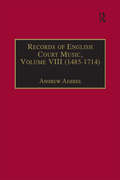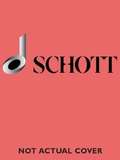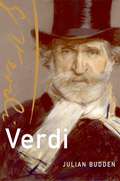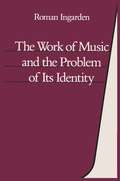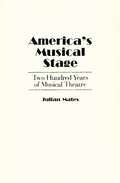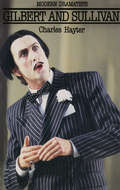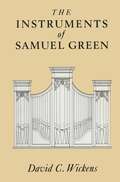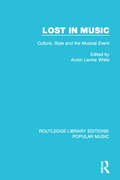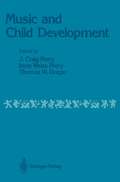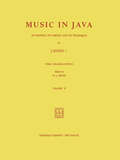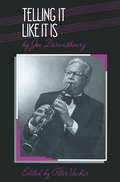- Table View
- List View
Records of English Court Music: Volume VIII : 1485-1714
by Andrew AshbeePioneering work on the musical material from the archives of the English court was undertaken by Nagel (1894), Lafontaine (1909) and Stokes (in the Musical Antiquary 1903-1913). Records of English Court Music (a series of seven volumes covering the period 1485-1714) is the first attempt to compile a systematic calendar of such references. It aims to revise these earlier studies where necessary, adding significant details which researchers omitted, clarifying the context of documents and substituting current call-marks for defunct references. Volume V is primarily concerned with the post-Restoration years already partially covered in volumes I and II. The material from the Exchequer and Declared Accounts of the Treasurer of the Chamber has been revised to include references to trumpeters and drummers. Other sections are devoted to material outside the Lord Chamberlain's papers: the Signet Office Docquet Books, Secret Service accounts and more from the Exchequer; the Corporation of Musick (controlled by the Court musicians) and to the range of music material from accounts of the Receivers General. Samples from the comprehensive records of the Lord Steward's department (including those of the Cofferer of the Household) are also provided. Andrew Ashbee was the winner of the Oldman Prize in 1987 for Volume II in the series of 'Records of English Court Music', awarded by the UK branch of the International Association of Music Libraries for the year's best book on music librarianship, bibliography and reference.
Records of English Court Music: Volume VIII : 1485-1714
by Andrew AshbeePioneering work on the musical material from the archives of the English court was undertaken by Nagel (1894), Lafontaine (1909) and Stokes (in the Musical Antiquary 1903-1913). Records of English Court Music (a series of seven volumes covering the period 1485-1714) is the first attempt to compile a systematic calendar of such references. It aims to revise these earlier studies where necessary, adding significant details which researchers omitted, clarifying the context of documents and substituting current call-marks for defunct references. Volume V is primarily concerned with the post-Restoration years already partially covered in volumes I and II. The material from the Exchequer and Declared Accounts of the Treasurer of the Chamber has been revised to include references to trumpeters and drummers. Other sections are devoted to material outside the Lord Chamberlain's papers: the Signet Office Docquet Books, Secret Service accounts and more from the Exchequer; the Corporation of Musick (controlled by the Court musicians) and to the range of music material from accounts of the Receivers General. Samples from the comprehensive records of the Lord Steward's department (including those of the Cofferer of the Household) are also provided. Andrew Ashbee was the winner of the Oldman Prize in 1987 for Volume II in the series of 'Records of English Court Music', awarded by the UK branch of the International Association of Music Libraries for the year's best book on music librarianship, bibliography and reference.
Tarnished Gold: Record Industry Revisited
by R. Serge DenisoffThe great depression in the popular recording industry that began in 1979 still continues. There are signs, however, that the industry is adjusting to new technologies and may soon revive. R. Serge Denisoff documents the decline and possible revival of this comprehensive study of the recording business, a sequel to his widely acclaimed Solid Gold: The Popular Record Industry. Denisoff offers a brief history of popular music and then, in detail, traces the life cycle of a record, beginning with the artist in the studio and following the record until its purchase. He explains the relationships between artist, manager, producer, company, distributor, merchandiser, and media. They all play roles in the scenario of a hit record. He also discusses the new technologies and how they may affect record sales, especially round-the-clock rock and roll on cable television. Tarnished Gold joins Solid Gold as a staple in the popular culture literature.
Tarnished Gold: Record Industry Revisited
by R. Serge DenisoffThe great depression in the popular recording industry that began in 1979 still continues. There are signs, however, that the industry is adjusting to new technologies and may soon revive. R. Serge Denisoff documents the decline and possible revival of this comprehensive study of the recording business, a sequel to his widely acclaimed Solid Gold: The Popular Record Industry. Denisoff offers a brief history of popular music and then, in detail, traces the life cycle of a record, beginning with the artist in the studio and following the record until its purchase. He explains the relationships between artist, manager, producer, company, distributor, merchandiser, and media. They all play roles in the scenario of a hit record. He also discusses the new technologies and how they may affect record sales, especially round-the-clock rock and roll on cable television. Tarnished Gold joins Solid Gold as a staple in the popular culture literature.
Verdi (Master Musicians Series)
by Julian BuddenIn this third edition of the classic Verdi, renowned authority Julian Budden offers a comprehensive overview of Verdi the man and the artist, tracing his ascent from humble beginnings to the status of a cultural patriarch of the new Italy, whose cause he had done much to promote, and demonstrating the gradual enlargement over the years of his artistic vision. This concise study is an accessible, insightful, and engaging summation of Verdi scholarship, acquainting the non-specialist with the personal details Verdi's life, with the operatic world in which he worked, and with his political ideas, his intellectual vision, and his powerful means of communicating them through his music. In his survey of the music itself, Budden emphasizes the unique character of each work as well as the developing sophistication of Verdi's style. He covers all of the operas, the late religious works, the songs, and the string quartet. A glossary explains even the most obscure operatic terms current in Verdi's time.
The Work of Music: and the Problem of its Identity
by Roman Ingarden Adam Czerniawski Jean G HarrellAmerica's Musical Stage: Two Hundred Years of Musical Theatre
by Julian Mates[This book is] a comprehensive illustrated history of the U.S. musical from its colonial origins to the present, tracing the connections and influences of the minstrel show, operetta, burlesque, melodrama, revues, circus, dance, musical comedy, the Broadway opera, the book musical and other forms. . . . Further, Mates introduces readers to inside stuff--the various types of musical performers. VarietyAmerican musical theatre has developed as an idigenous art form, with a long history, amazing vitality, and a variety of expression. Julian Mates is the first to show the musical stage in all its guises--from burlesque to musical comedy to grand opera--from its beginning in pre-Revolutionary America to the present day. In addition, this book is the first to explore the relationships between the various forms of musical theatre.
Cross-Overs: Art Into Pop/Pop Into Art (Routledge Library Editions: Popular Music Ser.)
by John A. WalkerThis book, first published in 1987, was the first major survey of the links between the visual arts and pop music over the last thirty years. It brings to light the ideas, styles and people who have influenced both the look of pop and the shape of art. It examines how pop uses art movements like Dada, Futurism and Surrealism in everything from the design of album covers to the creation of a group’s look, stage act and video; how art uses pop, as a subject for painting, sculpture and design; the vital role of the British art school connection; and collaborations and cross-overs – between the visual arts and groups, musicians and movements.
Cross-Overs: Art Into Pop/Pop Into Art (Routledge Library Editions: Popular Music Ser.)
by John A. WalkerThis book, first published in 1987, was the first major survey of the links between the visual arts and pop music over the last thirty years. It brings to light the ideas, styles and people who have influenced both the look of pop and the shape of art. It examines how pop uses art movements like Dada, Futurism and Surrealism in everything from the design of album covers to the creation of a group’s look, stage act and video; how art uses pop, as a subject for painting, sculpture and design; the vital role of the British art school connection; and collaborations and cross-overs – between the visual arts and groups, musicians and movements.
Duke Ellington: His Life And Music (Roots Of Jazz Ser.)
by Peter GammondThough first published in 1987, the Duke’s music is timeless, and this excellent book, written by musicologist Peter Gammond, is now available as a modestly priced ebook. With numerous black & white historic photos, the readable narrative provides a chronological history of Duke Ellington’s musical career starting as a part time pianist at Washington’s Poodle Dog Cafe up to his death in 1974. But with its alphabetic list of all the sideman who ever worked with the Duke together with a detailed discography this book should be particularly prized as an essential reference work by all dedicated jazz enthusiasts: it lists all the Duke’s recorded work from East St Louis Toodle-oo in 1926 to the live recording of the Eastbourne Concert in 1973, faithfully detailing all the supporting sidemen on each recording date.
Harpsichord and Lute Music in 17th-Century France
by D. LedbetterThe works of the 17th-century French harpsichord composers, the clavecinistes, are among the principal treasures of the harpsichord repertoire. It is a commmonplace of music histories that their style was strongly influenced by contemporary lutenists, yet the assessment of this influence has until now been limited to pointing out a few superficial resemblances. This book is the first comprehensive account of the relationship between the two styles. The nature and extent of the influence can now be seen as much more far-reaching than has been supposed. The clavecinistes adopted many details of lute style, and an understanding of these is essential for the proper performance of their works. More importantly, the lute style opened up the possibility of an entirely new expressive dimension in the playing of the harpsichord; in exploring this the clavecinistes evolved a style which dominated European keyboard music in the 17th-century, and provided a basis for the subsequent development of idiomatic keyboard style.
A History of the Oratorio: Vol. 3: the Oratorio in the Classical Era
by Howard E. SmitherThe Oratorio in the classical Era is the third volume of Howard Smither's monumental History of the Oratorio, continuing his synthesis and critical appraisal of the oratorio. His comprehensive study surpasses in scope and treatment all previous works on the subject. A fourth and final volume, on the oratorio in the nineteenth and twentieth centuries, is forthcoming.In this volume Smither discusses the Italian oratorio from the 1720s to the early nineteenth century and oratorios from other parts of Europe from the 1750s to the nineteenth century. Drawing on works that represent various types, languages, and geographical areas, Smither treats the general characteristics of oratorio libretto and music and analyzes twenty-two oratorios from Italy, England, Germany, France, and Russia. He synthesizes the results of specialized studies and contributes new material based on firsthand study of eighteenth-century music manuscripts and printed librettos. Emphasizing the large number of social contexts within which oratorios were heard, Smither discussed examples in Italy such as the Congregation of the Oratory, lay contrafraternities, and educational institutions. He examines oratorio performances in German courts, London theaters and English provincial festivals, and the Parisian Concert spirituel. Though the volume concentrates primarily on eighteenth-century oratorio from the early to the late Classical styles, Smither includes such transitional works as the oratorios of Jean-Francios le Seur in Paris and Stepan Anikievich Degtiarev in Moscow.A History of the Oratorio is the first full-length history of the genre since Arnold Schering's 1911 study. In addition to synthesizing current thought about the oratorio, this volume contributes new information on relationships between oratorio librettos and contemporary literary and religious thought, and on the musical differences among oratorios from different geographical-cultural regions.Originally published in 1987.A UNC Press Enduring Edition -- UNC Press Enduring Editions use the latest in digital technology to make available again books from our distinguished backlist that were previously out of print. These editions are published unaltered from the original, and are presented in affordable paperback formats, bringing readers both historical and cultural value.
The Instruments of Samuel Green (Macmillan Organ Studies)
by David C WickensA detailed survey and catalogue of the life and works of the English organ builder Samuel Green (1740-1796). A short biographical survey traces Green's career to the period when he established himself as the foremost English builder of organs of the late 18th century. This is followed by a detailed account of the design and constructional method of his chamber instruments and church organs. A chronological survey of his entire output gives the specification and history of each instrument and a reassessment of earlier sources. The text is illustrated with photographs and line drawings showing the characteristic features of Green's organ construction.
Late Renaissance Music at the Hapsburg Court (Musicology)
by C. P. ComberiatiFirst Published in 1987. Routledge is an imprint of Taylor & Francis, an informa company.
Late Renaissance Music at the Hapsburg Court (Musicology)
by C. P. ComberiatiFirst Published in 1987. Routledge is an imprint of Taylor & Francis, an informa company.
Lost in Music: Culture, Style and the Musical Event (Routledge Library Editions: Popular Music)
by Avron Levine WhiteThis collection of essays, first published in 1987, provides a sociological treatment of many musical forms – rock, jazz, classical – with special emphasis on the perspective of the practising musician. Among the topics covered are the legal structures governing musical production and the question of copyright; recording and production technology; the social character of musical style; and the impact of lyrical content, considered socially and historically.
Lost in Music: Culture, Style and the Musical Event (Routledge Library Editions: Popular Music)
by Avron Levine WhiteThis collection of essays, first published in 1987, provides a sociological treatment of many musical forms – rock, jazz, classical – with special emphasis on the perspective of the practising musician. Among the topics covered are the legal structures governing musical production and the question of copyright; recording and production technology; the social character of musical style; and the impact of lyrical content, considered socially and historically.
Music and Child Development
by Irene WeissPeery J. CraigPeery Thomas W. DraperI acknowledge a deep debt of gratitude to my coeditors: my wife Irene, and my friend and colleague Tom Draper. They have worked with diligence and insight to bring this work to completion. They have delegated the task of writing the Preface to me. As the scientific study of human development matures it is not only natural, but it is necessary to reach beyond understanding the ways humans develop capacities, to study the ways emerging capacities fit into the larger sphere of human undertakings. Music is one of the most significant of those endeavors. As I attend the several piano competitions that are on my agenda each year, and see children seated at the keyboard drawing forth the magnificent sounds of Bach, Chopin, and Ravel, I am always a little awed. Surely, it seems to me, the piano* is among the best of man's creations; the creative energies of great composers are among mankind's greatest expressions; and encouraging children to associate themselves seriously with both instrument and composer can be one of the great blessings to their young lives and, by association, to the larger society. Music touches the entire range of our lifespan on a daily basis. Involving chil dren with music and music training has high market, and common sense, validity. Parents understand intuitively that children will benefit, and their lives will be enriched, if they are influenced by music and music training.
The Nation's Image: French Grand Opera As Politics And Politicized Art (PDF)
by Jane FulcherFrench grand opera, this book argues, was a different and more complex kind of theater than we ordinarily suppose. Focusing on the period of grand opera's rise, its dominance, and its final decline, Professor Fulcher shows that it was a subtly used tool of the state. Using the Opera's archives, she analyses the mechanism and goals of state intervention in the theatre and how these underwent subtle change. As she demonstrates, the official framework helped to shape not only the nature of artistic development, but also politicized the theatrical experience itself. Although concerned with the audience's understanding of the operas, this book is not narrowly a 'reception history'. Rather, it is an attempt to see the part played by grand opera in a specific social and cultural context - how it arose within larger structures and in turn reacted back finally upon them.
Telling It Like It Is
by Joe Darensbourg Peter VacherThe autobiography of one of the foremost jazz clarinetists who is well known for his recordings with Edward 'Kid' Ory and the Louis Armstrong All Stars. Darensbourg was born in Baton Rouge, LA, in 1906 and heard many early New Orleans jazz bands as a young boy. For most of his life he lived on the West Coast and the book is a first-rate reference source for students of jazz and popular music in the urban centres of Seattle and Los Angeles.
